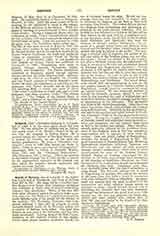

Arnulf of Bavaria, son of Luitpold of the Agilulfing family and of Kunigunde, and Duke of Bavaria from 907 to 937. His reign fell in a troubled time. The Magyars had begun their predatory incursions into Germany, in which they destroyed everything, wherever they penetrated. When, in the year 907, they again advanced against Bavaria in larger numbers than ever, the Margrave Luitpold summoned the entire fighting force of his people for the defense of the country. The Bavarians, however, were completely defeated, July 5, 907, in a battle in which Luitpold himself, nearly all the Bavarian nobles, and a number of bishops, were killed. The land then became an easy prey to the barbarians and was ruthlessly devastated. Ludwig, King of the East Franks, withdrew to the western division of the empire. Under these almost hopeless conditions Arnulf, the son of Luitpold, began his reign. He did not lose courage, however, and succeeded, August 11, 909, in defeating the Magyars on the Rott as they were returning from Swabia. This defeat did not prevent the Magyars from undertaking new plundering expeditions in the years directly following. But the terrible foe was defeated in a battle on the Inn not far from Passau, in the year 913, by a combined army of the Bavarians under Arnulf and of the Swabians under Erchanger and Berchtold, who were the brothers of Arnulf’s mother, Kunigunde. On account of a quarrel which broke out between King Conrad and the Swabian dukes, Arnulf took up arms against the king in favor of his uncles. The marriage of Conrad with Kunigunde, the mother of Arnulf and sister of the Swabian dukes, did not allay the enmity. Arnulf was obliged to flee the country, but after a Swabian victory over the followers of the king he returned to Bavaria and established himself at Salzburg and Regensburg (Ratisbon). Conrad advanced in 916 against his stepson once more and defeated him, but was not able to drive him entirely out of the country. In order to put an end to this disorder, the German bishops held a synod in 916 at Hohenaltheim near Nordlingen. The synod threatened Arnulf with excommunication in case he did not present himself by October 7 before a synod at Regensburg. Arnulf, however, continued his struggle against Conrad. He was eventually induced to submit by Conrad’s successor, Henry I, but only after he was accorded the right of independent government in Bavaria, the right of coinage, and the right of appointment to the bishoprics. This agreement was made in 921, before Regensburg. After receiving these concessions Arnulf acknowledged the German king as his overlord. Otherwise, he was an independent ruler in his own land and called himself in his official documents “Duke of the Bavarians by the Grace of God“. During his struggle for the independence of Bavaria, Arnulf had confiscated many monastic estates and properties, and had granted these lands as fiefs to his nobles and soldiers. Many churches, already grievously affected by the predatory incursions of the Magyars, were in this way completely impoverished and, it appears, in some cases destroyed. Only one abbot, Egilolf of Niederaltaich, attended the Synod of Regensburg in 932. The great monasteries of Benediktbeuern, Isen, Moosburg, Niederaltaich, Schaftlarn, Schliersee, Tegernsee, and Wessobrunn, had lost almost all they possessed through Arnulf’s confiscations, which were at times countenanced by some of the German bishops. Drakolf, Bishop of Freising, encouraged by the example of the duke, appropriated some possessions of the churches of Schaftlarn, Moosburg, and Isen. On account of his confiscations Arnulf was nicknamed der Schlimme (the Bad). Conditions were, however, decidedly better after the duke’s submission to King Henry. The Bavarian bishops met in synod at Regensburg, January 14, 932, and in the summer of the same year they held a synod in connection with other territorial nobles at Dingolfing. An agreement was reached that the lands wrested from the monasteries and other religious houses should be returned to them. Arnulf himself showed zeal in rebuilding the churches that had been destroyed. Although the decisions of the synod were never fully carried out, the way was prepared for better conditions and more orderly rule. Arnulf died July 14, 937, and was buried in the church of St. Emmeram in Regensburg.
J. P. KIRSCH

